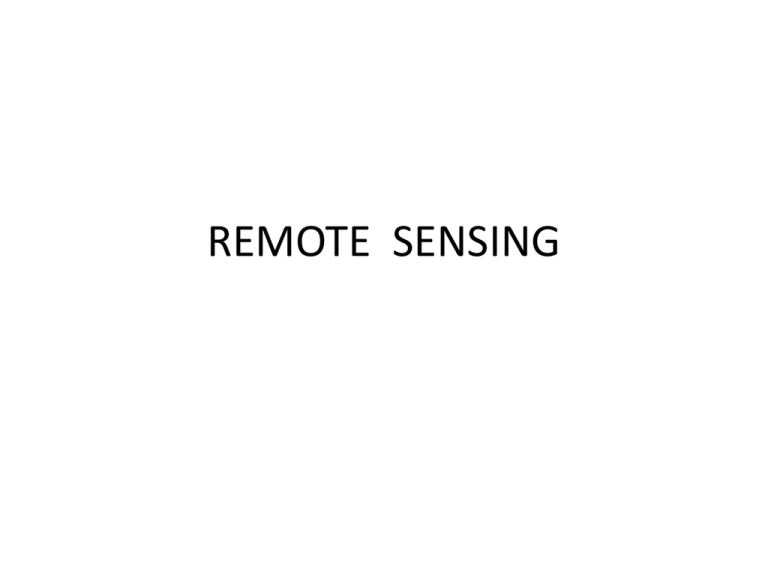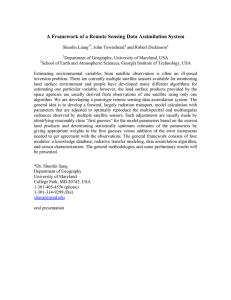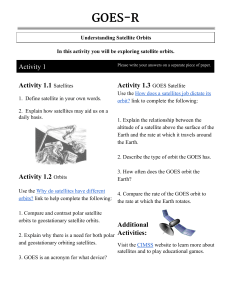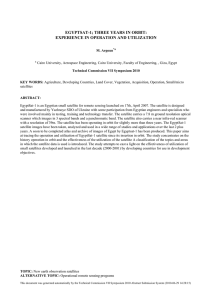Geography -Remote Sensing - Slide show free download
advertisement

REMOTE SENSING What is Remote Sensing? • Remote sensing is the technique of deriving information about objects on the Earth’s surface without physically coming into contact with them. • This process involves making observations using sensors (cameras, scanners, radiometer, radar etc.) • Mounted on platforms (aircraft and satellites), • Which are at a considerable height from the earth surface and • Recording the observations on a suitable medium (photographic films and videotapes or digital data on magnetic tapes). Types of Remote Sensing • There are two main types of remote sensings: • passive remote sensing and active remote sensing. • Passive sensors detect natural radiation that is emitted or reflected by the object or surrounding areas. Examples of passive remote sensors – camera using film. • Active sensors, on the other hand, emit energy in order to scan objects and areas and the sensor then detects and measures the radiation that is reflected from the target. • RADAR and LiDAR are examples of active remote sensing. History of RS • The modern discipline of remote sensing arose with the development of flight. • The balloonist G. Tournachon made photographs of Paris from his balloon in 1858. • Messenger pigeons, kites, rockets and unmanned balloons were also used for early images. • With the exception of balloons, these first, individual images were not particularly useful for map making or for scientific purposes] • Systematic aerial photography was developed for military purposes during World War I. • The development of artificial satellites in the latter half of the 20th century allowed remote sensing to progress to a global scale. Early RS Platforms Remote Sensing Platforms • In order for a sensor to collect and record energy reflected or emitted from a target or surface, it must be placed on a stable platform above the the target or surface being observed. • Platforms for remote sensors may be situated : • On the ground, • On an aircraft or balloon (or some other platform within the Earth's atmosphere), or • On a spacecraft or satellite outside of the Earth's atmosphere. • Ground-based sensors are often used to record detailed information about the surface and latter compared with information collected from aircraft or satellite sensors. Sensors may be placed on a ladder, scaffolding, tall building, crane, etc • Aerial platforms are primarily airplanes, although helicopters are occasionally used. • In space, remote sensing is sometimes conducted from the space shuttle or, more commonly, from satellites. • Satellites are objects which revolve around Planets (Earth). • The moon is a natural satellite of the Earth. • Man-made satellites include those platforms launched for remote sensing, communication, and telemetry (location and navigation) purposes. • Because of their orbits, satellites permit repetitive coverage of the Earth's surface on a continuous basis. • Cost is often a significant factor in choosing among the various platform options. Geostationary Orbit • The path followed by a satellite is referred to as its orbit. • Satellite orbits depend on the objective of the sensor. • Satellites at very high altitudes, which view the same portion of the Earth's surface at all times have geostationary orbits. • These geostationary satellites, at altitudes of approximately 36,000 kilometres, revolve at speeds which match the rotation of the Earth so they seem stationary, relative to the Earth's surface. • This allows the satellites to observe and collect information about a particular area continuously . • Weather and communications satellites commonly have these types of orbits. • Due to their high altitude, some geostationary weather satellites can monitor weather and cloud patterns covering an entire hemisphere of the Earth. Geostationary - Orbits - Near Polar Near-Polar Sun-Synchronous Orbit • Many remote sensing platforms are designed to follow a north south orbit which, allows them to cover most of the Earth's surface over a certain period of time. • These are near-polar orbits, so named for the inclination of the orbit relative to a line running between the North and South poles. • Many of these satellite orbits are also sunsynchronous such that they cover each area of the world at a constant local time of day called local sun time. • At any given latitude, the position of the sun in the sky as the satellite passes overhead will be the same within the same season. Satellite Passes • Most of the remote sensing satellite today are in near-polar orbits. • This means that the satellite travels northwards on one side of the Earth and then southwards on the second half of its orbit. • These are called ascending and descending passes. • If the orbit is also sun-synchronous, the ascending pass is most likely on the shadowed side of the Earth while the descending pass is on the sunlit side. • Sensors recording reflected solar energy only image the surface on a descending pass, when solar illumination is available. Active sensors which provide their own illumination can also image the surface on ascending passes. Ascending and Descending Passes Swath and Pass • As a satellite revolves around the Earth, the sensor "sees" a certain portion of the Earth's surface. • The area imaged on the surface, is referred to as the swath. • As the satellite orbits the Earth from pole to pole, its east-west position wouldn't change if the Earth didn't rotate. • However, as seen from the Earth, it seems that the satellite is shifting westward because the Earth is rotating (from west to east) beneath it. • This apparent movement allows the satellite swath to cover a new area with each consecutive pass. • The satellite's orbit and the rotation of the Earth work together to allow complete coverage of the Earth's surface, after it has completed one complete cycle of orbits. Uses of Remote Sensing • Remote sensing has the ability to provide a birds eye view of a large area of the earth’s surface in one frame. • Remote sensing makes it possible to collect data on dangerous or inaccessible areas. • Remote sensing also replaces costly and slow data collection on the ground, ensuring in the process that areas or objects are not disturbed. • Orbital platforms collect and transmit data from different parts of the electromagnetic spectrum. • Other uses include Natural resource Management, agricultural fields such as land use and conservation, etc., • Remote sensing applications include monitoring deforestation , glacial features in Arctic and Antarctic regions, and ocean depths. Spatial resolution • The detail discernible in an image is dependent on the spatial resolution of the sensor and refers to the size of the smallest possible feature that can be detected. Spatial resolution of passive sensors depends primarily on their Instantaneous Field of View (IFOV)... • most remote sensing images are composed of a matrix of picture elements, or pixels, which are the smallest units of an image. • Image pixels are normally square and represent a certain area on an image. Radiometric resolution • The radiometric resolution of an imaging system describes its ability to discriminate very slight differences in energy The finer the radiometric resolution of a sensor, the more sensitive it is to detecting small differences in reflected or emitted energy. By comparing a 2-bit image with an 8-bit image, we can see that there is a large difference in the level of detail depending on their radiometric resolutions. Temporal Resolution • the concept of revisit period, which refers to the length of time it takes for a satellite to complete one entire orbit cycle. • The revisit period of a satellite sensor is usually several days. Therefore the absolute temporal resolution of a remote sensing system to image the exact same area at the same viewing angle a second time is equal to this period. • Remote sensing has the ability to collect imagery of the same area of the Earth's surface at different periods of time. • Changes can be detected by collecting and comparing multi-temporal imagery. Aryabhata India’s first Satellite launched -19 April 1975 • Bhaskara 1 was India’s First experimental remote sensing satellite -7 June 1979 . • IRS 1A -First operational remote sensing satellite - 17 March 1988 . • Oceansat-1 (IRS P4) - 26 May 1999. • Resourcesat-1 (replaced IRS IC and ID) -17 October 2003. • Resourcesat-2 - 20 April 2011 IKONOS satellite was lauched on 24 September 1999. IKONOS images can reach spatial resolutions of 4 m in multispectral mode and of 82 cm in panchromatic mode. It is operated by the company GeoEye (USA). IKONOS image detail (0.8 m resolution) of the Rio de Janeiro Port, Brasil (20/04/02). Ikonos Quick Bird QuickBird was launched on 18 October 2001. It collects image data to 0.61 m pixel resolution degree of detail. It is owned and operated by the company DigitalGlobe (USA). Quickbird QuickBird satellite image of the southwester n coast of Sri Lanka GeoEye-1 was launched on 6 September 2008. It is also operated by the company GeoEye (USA). GeoEye-1 provides imagery with 41 cm resolution in panchromatic mode and 1.65 m in multispectral mode. Korea's Kompsat-2 satellite was launched on 28 July 2006. Kompsat-2 data have a resolution of 1 m in black and white and of 4 m in colour. Sydney, Australia; Olympic Park Durrat Al Bahrain - KOMPSAT-2 . Formosat-2 is the first high resolution satellite offering daily revisit acquisition services. The satellite was launched by the Taiwanese space agency on 20 May 2004. Its maximum spatial resolution is 2 m. Rio de Janeiro - Brazil The SPOT (Satellites Pour l’Observation de la Terre or Earth-observing Satellites) remote-sensing programme was set up in 1978 by France in partnership with Belgium and Sweden. Perth -Australia Indus Valley Resourcesat -1 IRS-P6






